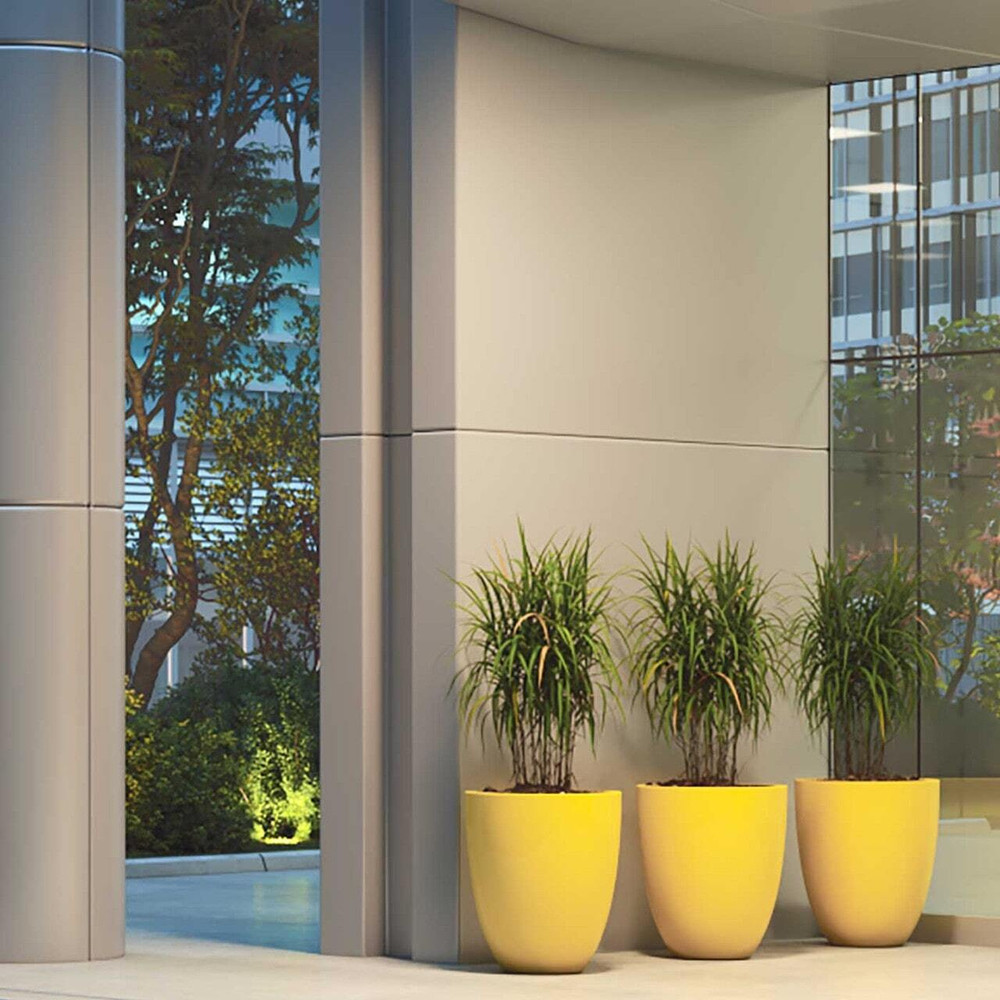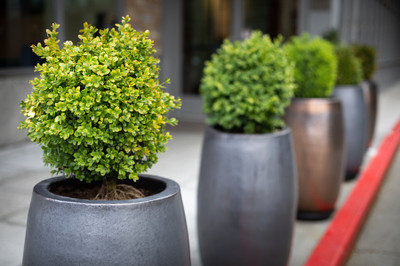How Planters Can Help Healthcare Facilities Improve Patient Well-Being
Posted by Jason Wyrwicz on May 8th 2025

Walk into any modern U.S. hospital or healthcare clinic, and you’ll notice a growing emphasis on comfort, aesthetics, and patient experience. Gone are the days when bare walls and stark lighting were the standard.
Today’s facilities strive to create healing environments that address not just the physical ailments of patients, but also their emotional and mental well-being.
It’s one reason why biophilic healthcare design—the integration of natural elements into built environments—has gained traction.
What is the role of planters and greenery in this healing ecosystem? Let’s explore.
The Science Behind Greenery and Healing
The physical environment can influence patient outcomes in several ways. The Facility Guidelines Institute (FGI) recommends designs that incorporate natural light and green spaces.
Roger S. Ulrich is often cited as one of the pioneers in evidence-based healthcare design. In his landmark study, Ulrich examined post-operative recovery in gallbladder surgery patients at a Pennsylvania hospital.
He compared two groups: one whose rooms had windows overlooking a row of trees and another whose windows faced a brick wall. The findings were striking:
- Shorter Hospital Stays
Patients with a view of nature recovered and were discharged, on average, nearly a full day sooner than those facing the wall.
- Reduced Need for Pain Medications
The tree-view group required fewer analgesics during their recovery period. Less pain medication indicated not only reduced pain levels but also potentially fewer side effects and lower medication costs.
- Fewer Negative Nurse Evaluations
Nurses recorded fewer negative notes regarding patients in the nature-view rooms, suggesting a more stable and less problematic recovery experience.
This isn’t just theoretical: multiple U.S. healthcare systems, from Johns Hopkins Medicine to the Mayo Clinic, have incorporated green design elements and reported increased patient satisfaction scores.
Indoor Greenery and Courtyard Plantings
In traditional biophilic design in healthcare architecture, floor-to-ceiling windows and courtyard gardens have often been the go-to solution to bring nature closer to the patient. However, these architectural features require significant upfront planning or renovation.
As a more flexible alternative, planters offer a cost-effective and modular way to achieve similar benefits. Large planters brimming with greenery can serve as visual anchors in waiting areas, while smaller planters in patient rooms contribute both aesthetic and functional benefits.
How Planters Make Greenery Possible—Anywhere
Flexibility and Mobility
Unlike permanent gardens or major renovations, planters can be placed almost anywhere—indoors or outdoors—offering unmatched flexibility.
- If a hospital corridor is narrow, choose slim rectangular planters that won’t crowd walkways.
- If a rooftop is underutilized, invest in large, durable planters designed to withstand changing weather conditions.
Because of this mobility, planters can also be rotated to different parts of a facility as needs evolve.
Scalable and Easy to Maintain
Not every healthcare facility has a robust facilities management team for plant upkeep, which is why planters that come with self-watering systems or low-maintenance plant species are crucial.
- Facilities managers can start with a few planters and scale up based on feedback and results. Whether it’s a single indoor planter in a waiting room or a full-scale installation on a rooftop, this approach keeps costs and complexity manageable.
- Moreover, fiberglass planters are made from easy-to-clean, non-porous material. This aligns perfectly with healthcare infection control standards set by the Centers for Disease Control and Prevention (CDC) and Occupational Safety and Health Administration (OSHA) guidelines.
In a hospital environment where sanitation is paramount, having planters that can be disinfected quickly is a game-changer.
Creating Visual Continuity
Planters can also help achieve biophilic design in healthcare facilities by establishing a visual flow from the outdoors to the indoors.
- For example, you might place matching planters at the entrance and continue that same style along hallways, waiting areas, or staff lounges.
This consistency can help patients navigate the facility more intuitively while enjoying the comforting presence of greenery.
High-Impact Areas to Place Planters in Healthcare Settings
Where should you start if you’re looking to integrate planters into a hospital or clinic? Below are five focal points that can yield significant benefits for both patients and staff.
1. Entrance / Drop-Off Zones
Calming, welcoming experiences
First impressions matter. Placing plants in hospital entrances can set a comforting tone the moment patients step inside. Large planters with vibrant greenery help soften the often-stressful environment of a hospital drop-off zone.
- Practical Tip: Use taller planters on either side of doorways to create a natural “green gateway,” fostering a sense of calm for visitors and patients.
2. Waiting Areas
Reduce anxiety with greenery
Waiting rooms are notorious for causing stress and anxiety. Introducing interior landscaping in hospitals—even small planters on tables or in corners—can significantly ease tension.
- Practical Tip: Consider seating arrangements that allow patients to view or sit near planters, improving the overall ambiance.
3. Courtyards / Gardens
Outdoor healing environments
If your facility already has a courtyard or garden space, planters can help define walking paths and create inviting seating nooks.
Courtyard gardens are an excellent way to engage patients in mild physical activity and encourage moments of reflection, which can be beneficial in rehabilitation or long-term care settings.
- Practical Tip: Combine flowering plants with lush greenery in a mix of fixed beds and movable planters to adapt the space for different seasons and activities.
4. Rooftops
Therapeutic gardens in otherwise unused spaces
Especially in urban environments, rooftops often remain underused. Planters designed for rooftops can transform these areas into therapeutic gardens where patients and staff can take a break from the clinical environment. These spaces can also provide stunning city views, further enhancing relaxation.
- Practical Tip: Select fiberglass planters that are weather-resistant and include good drainage systems, as rooftops can experience high winds. and variable weather conditions.
5. Hallways
Break up sterile clinical corridors with green “rest” points
Long, white corridors can feel overwhelming. Strategically placed planters can serve as visual breaks, creating short “rest stops” that reduce stress and monotony. This is also beneficial for staff who traverse these hallways multiple times a day.
- Practical Tip: Opt for narrower planters or wall-mounted options if space is tight, ensuring clear passage for wheelchairs and foot traffic.
Planter Types and Features Ideal for Healthcare Environments
What are critical factors to consider when selecting planters for biophilic design in healthcare projects?
Material
- Fiberglass
Lightweight yet durable, fiberglass has become a top choice for healthcare settings. It’s non-porous and easy to sanitize, aligning with infection control protocols. Fiberglass planters can also be molded into various shapes, from sleek rectangular forms to tall, sculptural pieces.
- Other Options
Stainless steel or high-grade plastic can also work, but fiberglass strikes the best balance between durability, aesthetics, and cost-effectiveness.
Design
- Modern, clean lines
Today’s hospitals often feature contemporary interior designs with straight lines, minimal color palettes, and simple decorative elements. Planters that mirror this style can seamlessly blend into lobbies, hallways, or waiting areas.
- Finish and Color
Opt for neutral or subtle finishes that complement existing decor. While bright-colored planters can add a pop of vibrancy, make sure they don’t clash with the facility’s overall mood.
Size / Shape
- Low and wide for lobbies
In large, open spaces like lobbies, wide planters can provide a striking focal point. They also create a visual boundary that can help guide foot traffic.
- Tall and narrow for hallways
Corridors benefit from slimmer planters that take up minimal floor space. This ensures compliance with ADA Standards for Accessible Design, maintaining the required width for wheelchairs and other mobility aids.
- Modular options for flexibility
Modular planters can be combined or separated for different event setups or seasonal displays, giving you the freedom to redesign spaces quickly.
Self-Watering Systems
- Reduces maintenance burden
Busy healthcare facilities can’t always allocate staff to water plants daily. A self-watering system can drastically cut down on upkeep. These systems typically include reservoirs that hold water for several days, ensuring plants stay hydrated even over long weekends or holiday breaks.
- Promotes sustainability
Self-watering planters also reduce water waste, a critical consideration for LEED certifications or other green-building standards.
Mobility
- Easy to move for cleaning or rearranging
Rolling bases or lightweight materials (such as fiberglass) make it easy to relocate planters. In a hospital, where routine deep cleaning and potential reconfiguration for large equipment movement are common, mobility is key.
- Adapt to changing needs
Facilities evolve, whether expanding an oncology wing or repurposing a common area into a specialized clinic. Mobile planters give you the freedom to adapt without significant renovation costs.
Showcase: 4 Planter Styles for U.S. Healthcare Spaces
Conclusion: Small Changes, Big Impact
Designing a healthcare facility that truly fosters patient well-being doesn’t have to be a massive, multimillion-dollar project. Simple additions like planters filled with lush greenery can go a long way toward creating a peaceful, healing environment.
Even the smallest steps toward integrating nature can yield significant mental, emotional, and physiological benefits for patients. And from a practical standpoint, staff and visitors also appreciate the break from the often-sterile surroundings in hospitals.
It’s a win-win all around—improved aesthetics, boosted morale, and potentially faster recoveries.











